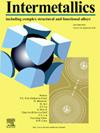Fcc TiFeCoNi-based medium and high-entropy alloys: corrosion and antibacterial behavior
IF 4.8
2区 材料科学
Q2 CHEMISTRY, PHYSICAL
引用次数: 0
Abstract
A quasi-equiatomic Ti25Fe25Co25Ni25 medium entropy alloy (MEA) and a Ti20Fe20Co20Ni20Cu20 high entropy alloy (HEA) were synthesized via mechanical alloying (MA) and spark plasma sintering (SPS). During the MA process, a single-phase FCC solid solution was detected. Following the SPS method, a dual-phasic structure consisting of FCC and Ti-rich intermetallic (C14-Laves) compounds was formed. An investigation was conducted to examine the role of Cu on the microstructural, corrosion, and antibacterial features of the TiFeCoNi alloy. Potentiodynamic polarization and electrochemical impedance spectroscopy (EIS) tests were employed for electrochemical investigation. The study revealed that the corrosion current density for MEA and HEA samples was documented as 4.30 × 10−6 A/cm2 and 5.88 × 10−6 A/cm2, respectively. The MEA sample exhibited a reduction of ∼16 % in capacitor double layer capacity and a rise of ∼216 % in charge transfer resistance, indicating its superior corrosion resistance compared to the HEA sample. Both samples experienced a combination of galvanic and pitting corrosion mechanisms. The antibacterial efficacy against S. aureus and E. coli demonstrated that the HEA sample exhibits superior antibacterial characteristics compared to the MEA sample, attributed to the release of Cu2+ ions. The inhibition zone diameters for the HEA sample against E. coli and S. aureus were measured to be 7.46 mm and 14.60 mm, respectively. In contrast, no inhibition zone was observed for the MEA sample against either bacterial strain.
Fcc tifeconi基中高熵合金:腐蚀和抗菌行为
采用机械合金化(MA)和放电等离子烧结(SPS)制备了准等原子Ti25Fe25Co25Ni25中熵合金(MEA)和Ti20Fe20Co20Ni20Cu20高熵合金(HEA)。在MA过程中,检测到单相FCC固溶体。采用SPS法制备了FCC和富钛金属间化合物(C14-Laves)组成的双相结构。研究了Cu对TiFeCoNi合金显微组织、腐蚀和抗菌性能的影响。电化学研究采用动电位极化和电化学阻抗谱(EIS)测试。研究表明,MEA和HEA样品的腐蚀电流密度分别为4.30 × 10−6 A/cm2和5.88 × 10−6 A/cm2。MEA样品的电容器双层容量减少了~ 16%,电荷转移电阻增加了~ 216%,这表明与HEA样品相比,MEA样品具有更好的耐腐蚀性。两个样品都经历了电偶腐蚀和点蚀机制的结合。对金黄色葡萄球菌和大肠杆菌的抑菌效果表明HEA样品比MEA样品具有更好的抑菌特性,这是由于HEA样品释放Cu2+离子所致。HEA样品对大肠杆菌和金黄色葡萄球菌的抑制带直径分别为7.46 mm和14.60 mm。相比之下,MEA样品对两种菌株均无抑制区。
本文章由计算机程序翻译,如有差异,请以英文原文为准。
求助全文
约1分钟内获得全文
求助全文
来源期刊

Intermetallics
工程技术-材料科学:综合
CiteScore
7.80
自引率
9.10%
发文量
291
审稿时长
37 days
期刊介绍:
This journal is a platform for publishing innovative research and overviews for advancing our understanding of the structure, property, and functionality of complex metallic alloys, including intermetallics, metallic glasses, and high entropy alloys.
The journal reports the science and engineering of metallic materials in the following aspects:
Theories and experiments which address the relationship between property and structure in all length scales.
Physical modeling and numerical simulations which provide a comprehensive understanding of experimental observations.
Stimulated methodologies to characterize the structure and chemistry of materials that correlate the properties.
Technological applications resulting from the understanding of property-structure relationship in materials.
Novel and cutting-edge results warranting rapid communication.
The journal also publishes special issues on selected topics and overviews by invitation only.
 求助内容:
求助内容: 应助结果提醒方式:
应助结果提醒方式:


